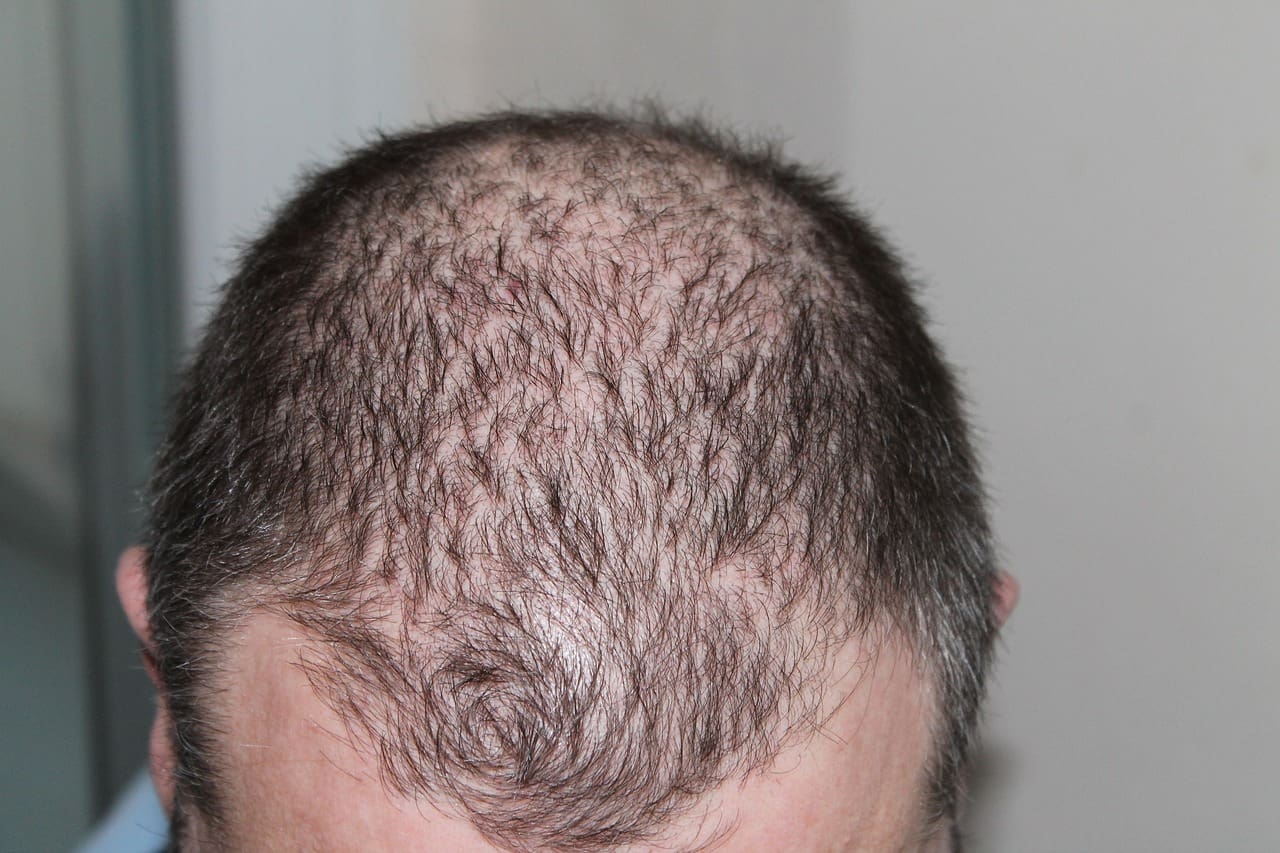Hair loss is a natural part of the aging process that many individuals experience. As we grow older, our hair may become thinner, and in some cases, we may even experience baldness. It is important to understand that hair loss is not something to be ashamed of or embarrassed about. Instead, it is an opportunity to embrace and accept our changing appearance with grace and confidence.
There is a strong connection between hair loss and aging. As we age, our hair follicles shrink and produce thinner and shorter strands of hair. Additionally, the production of melanin, the pigment responsible for hair color, decreases, leading to gray or white hair. These changes are a natural part of the aging process and should be embraced as a reflection of our life journey.
Embracing your changing look starts with self-acceptance and confidence. It is important to remember that our worth and beauty are not solely defined by our physical appearance. Instead, it is our inner qualities, character, and accomplishments that truly matter. By focusing on self-care practices, such as exercise, meditation, and positive affirmations, we can build self-acceptance and boost our confidence.
Hairstyling and fashion choices can also play a significant role in embracing our changing look. Experimenting with different hairstyles, accessories, and fashion choices can enhance our appearance and boost our confidence. Consider consulting with a hairstylist who specializes in hair loss to explore different options that suit your preferences and lifestyle.
Furthermore, it is important to remember that we are not alone in experiencing hair loss. Many individuals, both men and women, go through this natural process. Connecting with others who have similar experiences can provide support and reassurance. Consider joining support groups or online communities where you can share your journey and learn from others.
In conclusion, hair loss is a natural part of the aging process. Embracing and accepting our changing appearance is a journey that requires self-acceptance, confidence, and a positive mindset. By focusing on self-care practices, exploring different hairstyles and fashion choices, and connecting with others, we can embrace our changing look and age gracefully.
The Science Behind Hair Loss
As we age, it is natural for our hair to go through changes, including thinning and hair loss. Understanding the science behind these changes can help us better embrace and accept our evolving appearance.
Hair loss is primarily influenced by genetic and hormonal factors. Our hair follicles go through a growth cycle, which consists of a growth phase (anagen), a transitional phase (catagen), and a resting phase (telogen). As we age, the duration of the growth phase shortens, leading to shorter and thinner hair strands. Additionally, the resting phase becomes longer, resulting in more hair follicles entering the shedding phase.
Furthermore, hormonal changes play a significant role in hair loss. In both men and women, the hormone dihydrotestosterone (DHT) can bind to hair follicles and cause them to shrink. This process, known as miniaturization, leads to the production of thinner and shorter hairs, eventually resulting in hair loss.
Other factors that contribute to hair loss include inflammation, oxidative stress, and the accumulation of environmental toxins. These factors can damage hair follicles and disrupt the normal hair growth cycle.
While hair loss is a natural part of the aging process, it can still be distressing for many individuals. However, understanding the underlying science can help us approach it with acceptance and grace. By recognizing the biological processes at play, we can explore various strategies and treatments to support healthy hair growth and maintain confidence in our changing appearance.
Common Hair Loss Patterns
As we age, it is common for both men and women to experience hair loss and thinning. Understanding the different patterns of hair loss can help us better accept and embrace these changes in our appearance. Two common patterns of hair loss that people often experience with age are receding hairlines and thinning on the crown.
A receding hairline is characterized by the gradual loss of hair along the front of the scalp, resulting in a higher forehead. This pattern of hair loss is more common in men and is often one of the first signs of aging. Thinning on the crown, on the other hand, refers to the gradual thinning of hair at the top of the head, creating a more visible scalp. This pattern can affect both men and women, although it is more common in men.
It is important to note that hair loss patterns can vary from person to person. Some individuals may experience a combination of receding hairline and thinning on the crown, while others may only experience one of these patterns. Additionally, the severity of hair loss can also vary, ranging from mild to more extensive.
To better understand these patterns, let’s take a closer look at each:
- Receding Hairline: This pattern typically starts with a slight recession at the temples, forming an “M” shape. Over time, the hairline may continue to recede further back, creating a more pronounced “M” or “V” shape.
- Thinning on the Crown: With this pattern, the hair at the top of the head gradually becomes thinner and sparser. As a result, the scalp becomes more visible, especially under certain lighting conditions.
It’s important to remember that experiencing hair loss patterns is a natural part of the aging process. While it can be challenging to accept these changes, embracing them can lead to greater self-acceptance and confidence. There are also various options available to manage and address hair loss, such as hairstyles, accessories, and medical treatments, which we will explore further in this article.
Male Pattern Baldness
Male pattern baldness is a common form of hair loss that primarily affects men. It is characterized by a gradual thinning of the hair on the scalp, leading to a receding hairline and eventual baldness. This type of hair loss is also known as androgenetic alopecia, and it is believed to be caused by a combination of genetic and hormonal factors.
Genetics play a significant role in male pattern baldness, with studies suggesting that it can be inherited from either the mother’s or father’s side of the family. The condition is thought to be influenced by a specific gene called the androgen receptor gene, which can make hair follicles more sensitive to the effects of dihydrotestosterone (DHT), a hormone derived from testosterone.
When DHT binds to the androgen receptors in the hair follicles, it can cause them to shrink and produce shorter, thinner hairs. Over time, this can lead to the miniaturization of the hair follicles and the eventual cessation of hair growth. The exact mechanisms behind this process are still not fully understood, but it is believed to involve a combination of genetic predisposition and hormonal changes that occur with age.
While male pattern baldness is primarily influenced by genetics, hormonal factors also play a role in its development. Testosterone, the primary male sex hormone, is converted into DHT by an enzyme called 5-alpha reductase. Higher levels of DHT in the scalp can contribute to hair loss, especially in individuals who are genetically predisposed to male pattern baldness.
Other factors that may contribute to male pattern baldness include age, stress, and certain medical conditions. As men age, their hormone levels naturally fluctuate, which can impact the hair growth cycle. Additionally, chronic stress has been associated with hair loss, as it can disrupt the normal functioning of the hair follicles. Certain medical conditions, such as thyroid disorders and autoimmune diseases, can also contribute to hair loss in men.
It is important to note that male pattern baldness is a natural and common part of the aging process for many men. While it may be distressing for some individuals, there are various treatment options available to manage and slow down the progression of hair loss. These include medications like minoxidil and finasteride, hair transplant surgery, and lifestyle changes such as adopting a healthy diet and managing stress levels.
Overall, understanding the specific type of hair loss that affects men, known as male pattern baldness, and its causes can help individuals make informed decisions about their hair care and treatment options. By recognizing the genetic and hormonal factors involved, men can take proactive steps to manage their hair loss and embrace their changing appearance with confidence.
Hormonal Factors
Hormonal factors play a significant role in male pattern baldness, a common type of hair loss that affects many men as they age. Testosterone, a hormone present in both men and women, undergoes a process called conversion into dihydrotestosterone (DHT) with the help of an enzyme called 5-alpha reductase. DHT is known to bind to hair follicles, causing them to shrink and eventually leading to hair loss.
Genetics also play a crucial role in male pattern baldness. If you have a family history of baldness, particularly on your mother’s side, you may be genetically predisposed to experiencing hair loss. Certain genes can make your hair follicles more sensitive to DHT, increasing your risk of developing male pattern baldness.
It is important to note that hormonal factors and genetics are not the sole causes of male pattern baldness. Other factors, such as age, stress, and underlying medical conditions, can also contribute to hair loss. Understanding the role of hormones and genetics in male pattern baldness can help individuals make informed decisions about potential treatment options and lifestyle changes to manage their hair loss.
Treatment Options
Treatment options for male pattern baldness are varied and can be tailored to individual needs and preferences. It’s important to consult with a healthcare professional or a dermatologist to determine the most suitable option for you.
Medications: There are several medications available that can help slow down or even reverse hair loss in some cases. One common medication is minoxidil, which is applied topically to the scalp. It works by increasing blood flow to the hair follicles, promoting hair growth. Another medication is finasteride, which is taken orally and helps to block the conversion of testosterone into dihydrotestosterone (DHT), a hormone that can contribute to hair loss.
Hair transplant surgery: For those looking for a more permanent solution, hair transplant surgery can be an effective option. This procedure involves taking hair follicles from areas of the scalp that still have hair and transplanting them to areas where hair loss has occurred. The transplanted hair follicles continue to grow in their new location, providing a natural-looking result.
Lifestyle changes: Making certain lifestyle changes can also help manage male pattern baldness. A healthy diet rich in vitamins and minerals, regular exercise, and stress management techniques can all contribute to overall hair health. Additionally, avoiding harsh hair treatments and styles that pull on the hair can help prevent further damage and hair loss.
It’s important to note that not all treatment options work for everyone, and results may vary. It’s always best to consult with a healthcare professional before starting any treatment regimen. They can assess your specific situation and provide personalized recommendations based on your needs and goals.
Female Hair Loss
Female hair loss is a common concern that many women face as they age. It can be a source of distress and can significantly impact a woman’s self-esteem and confidence. Understanding the unique challenges and causes of hair loss in women is essential in finding effective solutions and embracing one’s changing appearance.
Hormonal imbalances play a significant role in female hair loss. Fluctuations in hormone levels, such as during pregnancy, menopause, or conditions like polycystic ovary syndrome (PCOS), can contribute to hair thinning and shedding. Hormonal imbalances can disrupt the hair growth cycle and lead to increased hair loss.
Stress is another factor that can contribute to hair loss in women. High levels of stress can disrupt the normal functioning of the hair follicles and lead to increased shedding. It is important for women to find healthy ways to manage stress, such as through relaxation techniques, exercise, and self-care practices.
Medical conditions can also be a cause of hair loss in women. Conditions like thyroid disorders, autoimmune diseases, and certain medications can affect the hair growth cycle and result in hair thinning and loss. It is important for women experiencing hair loss to consult with a healthcare professional to identify and address any underlying medical conditions.
Embracing and accepting hair loss in women can be challenging, but it is important to remember that beauty comes in many forms. Finding support from loved ones, seeking professional help if needed, and practicing self-care can all contribute to building self-acceptance and confidence. There are also various hairstyles, accessories, and fashion choices that can enhance a woman’s look and boost confidence despite hair loss.
Overall, understanding the unique challenges and causes of hair loss in women is crucial in finding effective solutions and embracing one’s changing appearance. By addressing hormonal imbalances, managing stress, and seeking medical advice when necessary, women can navigate the journey of hair loss with grace and confidence.
Embracing Your Changing Look
Embracing Your Changing Look
As we age, it’s natural for our appearance to change, and hair loss is often a part of that process. While it can be challenging to accept these changes, embracing your changing look can lead to a greater sense of self-acceptance and confidence. Here are some tips and advice on how to embrace and accept your changing appearance due to hair loss and aging gracefully.
1. Practice self-acceptance: Accepting your changing appearance starts with accepting yourself. Remember that beauty comes in many forms and is not solely defined by hair. Focus on your positive attributes and qualities that make you unique. Celebrate your inner beauty and let it shine through.
2. Take care of yourself: Self-care plays a vital role in how we feel about ourselves. Prioritize your physical and emotional well-being by engaging in activities that make you feel good. Exercise regularly, eat a balanced diet, get enough sleep, and manage stress. Taking care of yourself holistically can boost your confidence and help you embrace your changing look.
3. Experiment with hairstyles: Just because you may be experiencing hair loss doesn’t mean you can’t have fun with your hair. Experiment with different hairstyles that work with your current hair situation. Consult with a hairstylist who can provide guidance on flattering cuts and styling techniques that can enhance your look and boost your confidence.
4. Consider accessories: Accessories can be a great way to add flair and personality to your look. Explore different headscarves, hats, or hairpieces that can complement your style and make you feel more confident. Don’t be afraid to get creative and have fun with accessories that suit your taste.
5. Dress to impress: Your fashion choices can greatly influence how you feel about yourself. Choose clothing that makes you feel comfortable and confident. Experiment with different styles, colors, and patterns that reflect your personality. When you feel good about what you’re wearing, it can have a positive impact on your overall confidence.
6. Seek support: Surround yourself with a supportive network of friends and family who can uplift and encourage you on your journey of embracing your changing look. Share your feelings and experiences with trusted individuals who can provide a listening ear and offer valuable advice. Sometimes, talking to others who have gone through similar experiences can be incredibly empowering.
7. Practice positive affirmations: Affirmations are powerful tools that can help shift your mindset and promote self-acceptance. Repeat positive statements about yourself and your appearance daily. Remind yourself of your worth, inner beauty, and the unique qualities that make you who you are. Over time, these affirmations can help you embrace and accept your changing look with grace and confidence.
Remember, hair loss and aging are natural processes that many people experience. Embracing your changing look is about embracing yourself and finding beauty in all stages of life. By practicing self-acceptance, taking care of yourself, experimenting with hairstyles and accessories, dressing to impress, seeking support, and practicing positive affirmations, you can embrace your changing appearance and age gracefully.
Self-Acceptance and Confidence
In the face of hair loss, building self-acceptance and confidence is crucial. It’s important to remember that hair loss is a natural part of the aging process and does not define your worth or attractiveness. Here are some strategies to help you embrace your changing appearance and boost your self-esteem:
- Practice self-care: Taking care of yourself physically and emotionally can greatly improve your self-acceptance and confidence. Engage in activities that make you feel good, such as exercise, meditation, or hobbies that bring you joy.
- Adopt positive affirmations: Repeat positive affirmations to yourself daily to challenge negative thoughts and build self-confidence. Remind yourself of your unique qualities and strengths that go beyond your physical appearance.
- Seek support: Surround yourself with a supportive network of friends and family who can provide encouragement and understanding. Consider joining support groups or online communities where you can connect with others who are going through similar experiences.
- Explore new styles: Experiment with different hairstyles, accessories, and fashion choices that make you feel confident and comfortable. Consult with a hairstylist who specializes in working with clients experiencing hair loss to explore options that suit your preferences.
- Focus on inner beauty: Shift your focus from external appearance to inner qualities that make you unique and special. Cultivate qualities such as kindness, compassion, and resilience, which contribute to your overall attractiveness and confidence.
Remember, self-acceptance and confidence come from within. Embrace your changing look as a reflection of your journey and wisdom gained over the years. Celebrate your individuality and the beauty that radiates from your true self.
Hairstyling and Fashion Choices
When it comes to embracing your changing look due to hair loss, there are various hairstyling and fashion choices that can help enhance your overall appearance and boost your confidence. Here are some tips and ideas to consider:
- Hairstyles: Opt for shorter hairstyles that can make your hair appear fuller and thicker. Consider a buzz cut or a cropped style, which can be both trendy and low-maintenance. If you prefer longer hair, try layering to add volume and texture.
- Accessories: Accessories can be a great way to divert attention from hair loss. Hats, scarves, and headbands can not only cover up any thinning areas but also add a stylish touch to your overall look. Experiment with different styles and colors to find what suits you best.
- Fashion Choices: Wearing the right clothing can help draw attention away from your hair and focus on other aspects of your appearance. Opt for bold and vibrant colors that complement your skin tone and make you feel confident. Consider statement accessories, such as statement necklaces or earrings, to add a touch of glamour to your outfit.
Remember, the key is to experiment and find what works best for you. Don’t be afraid to try new styles and embrace your unique look. Confidence is the key to looking and feeling your best, regardless of hair loss. Embrace your changing appearance with pride and let your inner beauty shine through.
Frequently Asked Questions
- 1. Why does hair loss occur as we age?
Hair loss is a natural part of the aging process. As we get older, our hair follicles shrink and produce thinner and shorter hair strands. Additionally, hormonal changes, genetics, and other factors can contribute to hair loss.
- 2. What are the common patterns of hair loss in aging individuals?
Common patterns of hair loss include receding hairlines in men, thinning on the crown, and overall hair thinning in both men and women. These patterns can vary from person to person.
- 3. What is male pattern baldness?
Male pattern baldness is a specific type of hair loss that primarily affects men. It is characterized by a receding hairline and thinning hair on the crown of the head. Male pattern baldness is often influenced by genetics and hormonal factors.
- 4. Can hormonal changes contribute to male pattern baldness?
Yes, hormonal changes can play a role in male pattern baldness. The hormone dihydrotestosterone (DHT) is believed to be a contributing factor. As men age, the levels of DHT can increase, causing hair follicles to shrink and produce thinner hair strands.
- 5. What treatment options are available for male pattern baldness?
There are several treatment options for male pattern baldness, including medications such as minoxidil and finasteride. Hair transplant surgery is also an option for those seeking a more permanent solution. Additionally, making lifestyle changes such as maintaining a healthy diet and reducing stress can help improve hair health.
- 6. What are the unique challenges of hair loss in women?
Hair loss in women can be caused by hormonal imbalances, stress, medical conditions, and certain hairstyles or hair treatments. Women may experience overall thinning of the hair or widening of the part line.
- 7. How can I embrace and accept my changing appearance due to hair loss?
Embracing your changing appearance starts with self-acceptance and building confidence. Practice self-care, engage in positive affirmations, and surround yourself with supportive people. Acceptance of your new look can lead to a greater sense of self-confidence and happiness.
- 8. Are there any hairstyles or fashion choices that can enhance my look despite hair loss?
Absolutely! There are various hairstyles, accessories, and fashion choices that can help enhance your appearance and boost your confidence. Consider trying different hairstyles, such as shorter cuts or layered styles, that can create the illusion of volume. Experiment with headscarves, hats, or hair accessories to add flair to your look.








Leave a Reply